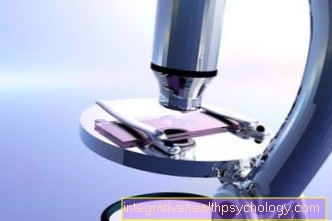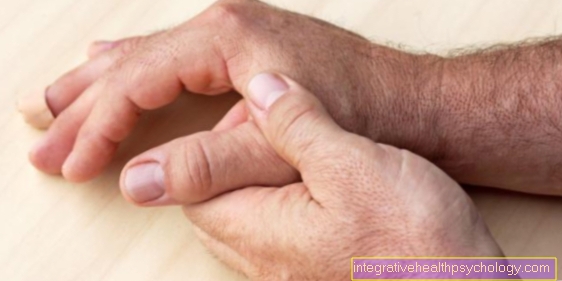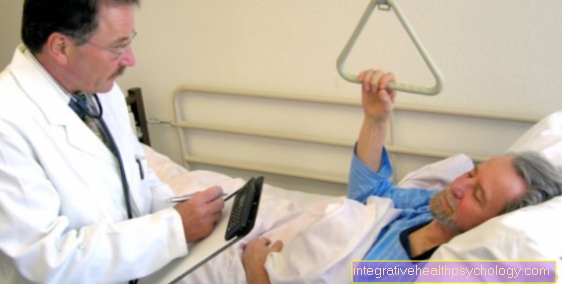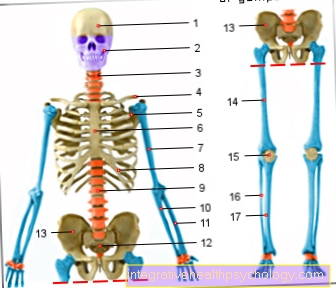Marfan Syndrome Diagnostics
The diagnosis of Marfan syndrome is carried out on an interdisciplinary basis through the collaboration of Cardiologists, Radiologists, ophthalmologists, human geneticists and general practitioners who work together to achieve an early diagnosis. In use today is the so-called Ghent nosology from 1996.
Skeletal system
- Main criteria (a main criterion is given if at least four of the following manifestations are detected):
- Keel breast (Pectus carinatum)
- Funnel breast (Pectus excavatum with indication for surgery)
- Scoliosis > 20 ° or Vortex sliding
- Reduced ratio of the upper to the lower half of the body (below 0.85; normal is 1.05)
- Positive thumb sign (When closing the fist, the end link of the thumb looks out of the fist)
- Positive wrist sign (when embracing your own wrist the thumb and little finger phalanx of the encompassing hand completely overlap)
- Restricted elongation (Extension) of Elbow joint
- Flat foot (Pes planus)
- Bulging of the acetabulum (protrusio acetabuli)
- Secondary criteria:
- mildly pronounced funnel breast
- Overmobility of the joints
- High, narrow (“Gothic”) palate
- Typical appearance: narrow skull (dolichocephalus), sunken eyes (endophthalmos), lower jaw ridge (retrognathia), underdevelopment of the cheekbones (hypoplasia), antimongoloid eyelid position
Meninges (dura)
- Main criteria:
- Meninges prolapse (Dura) in the area of the sacrum and coccyx (lumbosacral duraectasia)
- Secondary criteria:
- no
Cardiovascula
- Main criteria:
- Extension (Dilation) the ascending aorta (Ascending aorta) including the sinus valsalvae (Origin of the coronary vessels)
- Splitting (Dissection) of the ascending aorta
- Aortic regurgitation (Insufficient closure)
- Secondary criteria:
- Left heart valve prolapse (Mitral valve prolapse) with or without blood reflux (Mitral regurgitation)
- Expansion of the main pulmonary artery (Dilatation of the pulmonary artery) before the age of 40 without simultaneous narrowing (Stenosis) the pulmonary valve (Valve of the pulmonary arteries) or increased pulmonary resistance
- Calcified mitral annulus (Part of the left heart valve) before the age of 40
- Extension (Dilation) or splitting (dissection) of the descending thoracic or abdominal aorta before the age of 50
eye
- Main criteria:
- one-sided or double-sided displacement of the lens (Ektopia lentis)
- Secondary criteria:
- abnormally flat cornea (Cornea) (Evidence from a corneal measurement)
- Increased axial length of the Eyeball (Eyeball length)
- Under-wrapped iris (hypoplastic iris) or ciliary muscle
lung
- Main criteria:
- no
- Secondary criteria:
- spontaneous collapse of the lungs (spontaneous pneumothorax)
- Blistering in the tips of the lungs (apical bullae)
Skin and subcutaneous tissue
- Main criteria:
- no
- Secondary criteria:
- Stretch marks of the skin (striae atrophicae)
- recurrent hernias (hernias)
Genetics and family history
- Main criteria:
- 1st degree relative who meets these criteria
- FBN-1 mutation detection
- Evidence of a haplotype linked to Marfan's syndrome in the patient's family (Haploid genotype)
- Secondary criteria:
- no
The diagnosis results

1. in the case of a positive FBN-1 mutation detection with additional evidence of a main criterion in one organ system (e.g. the heart) and the involvement of a second organ system.
2. If there is a positive family history, i.e. a first-degree relative meets the criteria of Ghent nosology, a main criterion in one organ system and participation in a second organ system is also necessary for diagnosing the syndrome.
3. The diagnosis can also be made if, independently of a genetic analysis, the main criteria are present in two organ systems (e.g. heart and eyes are affected) and a third organ system (e.g. the skeleton) is involved.
Skeletal system
In the area of the skeleton, there is organ involvement if one component from the list of main criteria and two features from the list of secondary criteria are detected. Further diagnostic manifestations, which are usually determined radiologically, are the typical spider fingering caused by a disproportionate elongation of the phalanxes (Phalanges), even if they are not part of Ghent nosology. Other manifestations not listed are deformations of the spine. The spinal canal (Spinal canal) in the sacrum area (lumbosacral) is enlarged in 63% of patients, which can be confirmed by magnetic resonance imaging. Hammer toes, crooked toes (Hallux vulgaris) and clubfoot deformities. On the other hand, an elevated kneecap may occasionally appear on the kneePatellar high) and a hyperextension of the joint can be found. The premature development of osteoarthritis in the affected joints is not uncommon.
Cardiovascular system
In the area of the cardiovascular system, changes in the aorta or the heart valves can be visualized with the help of various imaging methods such as magnetic resonance imaging, transesophageal echocardiography (ultrasound examination of the esophagus) and computed tomography. Magnetic resonance tomography (MRT) and angiography (visualization of the vessels with contrast medium), as well as transthoracic echocardiography (ultrasound through the chest) are also used. Magnetic resonance imaging is considered the best method.
eye
The examination of the eye is carried out using a slit lamp, with the help of which the ophthalmologist can use a slit-shaped light beam to visualize the various sections of the eye and the retina and thus detach or detach the retinadislocation) of the lens. Organ involvement of the eye is given for at least two secondary criteria.
genetics
A greater reliability of the diagnosis has undoubtedly resulted from the increased use of genetic analysis, which has now been able to detect over 80 types of mutation in the fibrillin-1 gene that are responsible for the syndrome.
Additional information
Also read:
- Marfan's Syndrome
- Marfan Syndrome Signs
- You Are Here: Marfan Syndrome Diagnostics





























